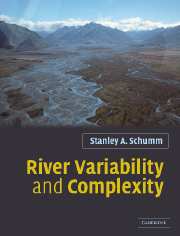Chapter 15 - Accidents
Published online by Cambridge University Press: 05 June 2012
Summary
Accidents (Figure 1.2), as discussed here, are unanticipated events. Most floods are not included (see Chapter 13) because they can be anticipated. For example, 100-year floods do eventually occur. Accidents are earthquakes, log jams, ice jams, avalanches, and volcanic eruptions, which are not normally anticipated and yet they produce dramatic channel changes and catastrophic floods.
Log jams and snags
Trees that fall into a channel can have a marked effect. In small channels, single trees can obstruct flow, thereby causing a back-water effect and sediment deposition. When the trees rot or are otherwise removed, incision into the sedimentary deposit will produce discontinuous terraces (Figure 15.1). Similar results occur as a result of beaver dam construction (Bigler, 2001). In a sinuous channel, the back-water effect of log jams can cause cutoffs. In mountain streams evidence of former jams is a major increase of channel width and the presence of mid-channel bars (Keller and Swanson, 1979).
Even larger rivers in forested regions can be blocked by numerous fallen trees (snags) causing an anastomosing pattern. For example, in 1872 the Willamette River in Oregon frequently had four or five channels. Unlike today's trees, the size of snags in the Willamette River ranged from 30 to 60 m long and up to 2 m in diameter. Clearing of the snags produced a single channel (Sedell and Froggatt, 1984).
- Type
- Chapter
- Information
- River Variability and Complexity , pp. 138 - 146Publisher: Cambridge University PressPrint publication year: 2005



